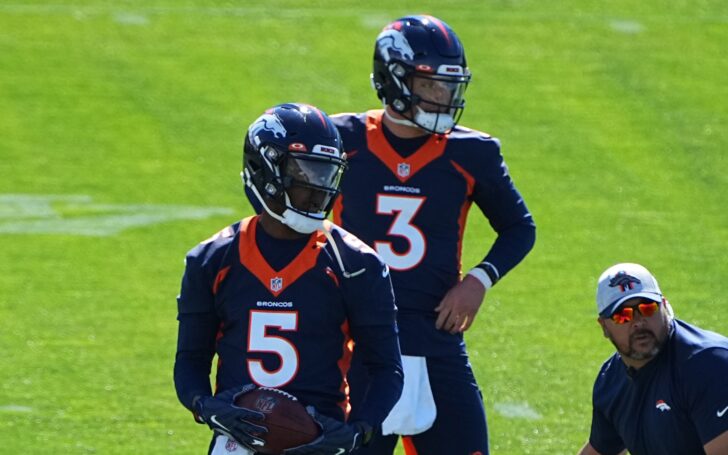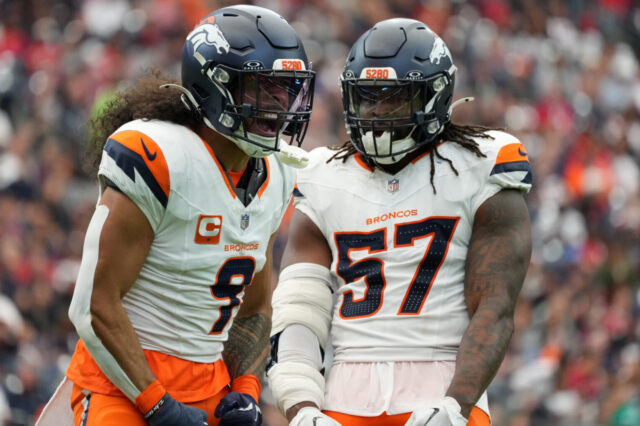Under normal circumstances, the preseason is used to evaluate the bottom half of the roster.
However, this preseason for Broncos Country the stakes are much higher. The Denver Broncos are evaluating a quarterback battle between incumbent Drew Lock and heady veteran Teddy Bridgewater, and a highly competitive battle at that.
It is difficult to know who is “winning” the competition with frequent tweets focusing on highlights and giving subjective scores to determine a winner of each day.
We can only see what is happening on the surface and the information we are not privy to could be what determines who will win this job and fans may miss the nuances behind what goes into this decision for a coach.
Is there a way for a fan watching on TV to identify this in a meaningful way?
The QB whisperer, Tim Jenkins, says, “abso-freakin-lutely.”
Episode 6️⃣2️⃣ QB guru Tim Jenkins (@TJenkinsElite) is in the house. He gives #BroncosCountry everything we need to know about the #Broncos QB battle between #DrewLock and #TeddyBridgewater.@MileHighSports
Link in bio for all platforms
Spotify Version 👇🏾 https://t.co/8rHfePENFR— Mile High Sports Symposium (@DocandJT) August 13, 2021
The former NFL quarterback and current coach for ‘Jenkins Elite‘ has six steps for Broncos fans to help them evaluate this quarterback competition like a pro coach would.
Which Broncos QB makes the right “Kill”, “Alert”, & “Orange” calls?
A common NFL running playcall is: “Twins Right F-Counter 50 OP Kill 60 Bruce”.
The phrase makes no sense to most fans, and understandably so. We aren’t taught to speak football growing up. However, don’t fret because it is more simple than it appears.
For this aspect of our evaluatiion we only need to focus on the “50 OP Kill 60 Bruce” part of the playcall.
“50 OP” (pronounced O.P.) is the original run call; inside zone to the weak side (op stands for open; meaning open side, no tight end).
If the defense lines up in an ‘over’ front, Lock or Bridgewater are good with that original call, because the ‘run bubble’ will be weak. However if the defense lines up in an ‘under’ front they are supposed to “kill-kill” the original play call (an in-depth breakdown of how to define an under or over front). Then Denver’s quarterback needs to check into their backup plan, “60 Bruce”, also known as, a strong-side outside zone call.
Utilizing that ‘backup plan’ for an NFL QB competition is important, because these checks get missed by young quarterbacks often.
If one of Denver’s passers is consistently making the correct run check and the other isn’t, that will be meaningful. The coaches will select whoever is best suited to lead the offense, and getting the offense set with the right play is a major part of that.
That’s great to know, sure, but how can one catch it during a TV broadcast?
Jenkins says to look for the QB exclaiming something like “Kill” or “Alert” at the line of scrimmage. Those calls usually mean a change to the next play in any offense. So if you hear Lock or Bridgewater shouting, “Kill-Kill” and that run play goes for three or more yards, you just witnessed a proper check.
A more advanced one to watch for is the “orange” call.
Generally, NFL quarterbacks yell “orange-orange” to alert to an opposite call. That means it’s used to change “60 Bruce” (outside zone to the right) to “70 Bruce” (outside zone to the left) in order to get an even more advantageous look.
If you’re curious for more information on the topic, Jenkins has already made a video taking a closer look.
The efficiency of the Broncos running game
Run game efficiency is one of the most important aspects of a quarterback competition. Truthfully it’s shameful that offensive coordinator Pat Shurmur hasn’t once been asked, “Who is getting the team in better run looks, Lock or Bridgewater?”
This also ties into catching the “Kill” calls, but run game efficiency should be much easier for the common fan to pick up on.
Is the running game for one quarterback always gaining at least three yards, while the other’s running game seems to be consistently stalling out? This is likely due to improper run game checks or ‘Mike’ defender declarations — another important pre-snap responsibility of the quarterback.
Behind the scenes in Dove Valley, this will be an important factor in determining who will lead the Orange and Blue this season.
Free rushers in pass protection
One of the most blatant signifiers to evaluate this battle from the outside, is free rushers in the passing game.
If free rusher is a result of a defensive line twist; when a defensive end loops inside and comes free it is usually not on the QB.
When a free runner comes from elsewhere on the defense, that is a different story.
Usually, such a free runner is the direct result of a bad ‘Mike declaration’, a missed sight adjustment, or another form of quarterback mistake. If you see an inside linebacker or defensive back running free through the backfield, and the QB takes a normal drop instead of trying to break off their drop to throw ‘hot’, that is a problem.
When watching from home look for how often Lock takes a sack because of a free runner? Does Bridgewater throw to the backside WR against a blitzing cornerback? All those situations will play into the staff’s decision of who’s starting.
Quick Game Completions
Evaluating ‘quick-game’ looks asks more of our common fan’s Football IQ.
First, to define it, a quick-game play would be any completion less than seven yards. For example, routes such as a slant, hitch, stick, or arrow would be parts of the quick game.
Every offensive coordinator calls these for one simple reason, completions.
These route concepts are used to horizontally stretch a defender, take advantage of rotational coverage, or pick a man defender, all of which results in an easy completion to get the offense going.
Now we need to take it to the next level and evaluate the types of quick-game plays. Generally, there are two different types: pure progressions and P.S.L-read plays.
First, pure progressions, which are generally run from a three-by-one formation (three receivers on one side and one receiver isolated backside). Pure progressions are looking from one route, to the next, to the next, regardless of the coverage.
The quick-game concepts are paired with a backside big alert, such as, ‘If Jeudy is one-on-one backside keep it simple and hit him.’
Then there are P.S.L type plays; these plays are highly complex but can be somewhat simplified.
For example, if the defense has two deep safeties, the quarterback reads one half of the field, and if there’s just one, he reads the other half. One play where this is the case, is the two-by-two concept, “Double Slant & Slant Arrow.”
If the Broncos were to run this play in game, you would want to see the quarterbacks read the double-slant side against a two-high look, and read the slant-arrow side against a single-high look.
Let’s say you’re unable to identify whether-or-not the quarterback is able to pick the right side of the P.S.L play, as it can be especially difficult with the TV broadcast. What do you do then?
Jenkins says to just keep it simple. Ask yourself, Did the QB complete the ball on that quick-game play? If one of these guys consistently completes a pass in quick-game, mark him as having an edge over the other guy.
Shot Plays
This is where the Broncos’ quarterback battle is going to be decided, based on the skill-sets of the two QBs in question.
Shurmur’s offense has a tremendous amount of ‘shot’ plays built into it, off of both run and play-action.
Run-action is when the offense pulls a lineman to further sell a run look. Meanwhile, play-action refers to a play where the offensive line is in pass-protection and only the backfield is executing the “run” fake.
Bridgewater and Lock both have different characteristics that could make or break this aspect of evaluation for them.
What fans should be looking for — and what the Broncos internally want to see — is No. 5 take advantage of the premier shot look when it is there.
One thing to watch for, is any improvement in Bridgewater’s ability to ‘hunt’ with the football and take the shot when it is called. You want to see him air-it-out when he has the correct look instead of settling for the ‘over’ route or shallow route.
Lock has the exact opposite goal.
Decision-makers at Dove Valley want to see him take those shallow and over-type routes more often when the ‘premier look’ isn’t there. He tends to hear a shot play get called and throw it no matter the look or coverage confirmation. This part of Lock’s game needs to grow if he is going to run away with this part of the evaluation.
Overall Efficiency
Finally, we need to look for overall offensive efficiency. Coaches love when a QB steps into the huddle and leads the offense downfield for points.
The first five traits will lead to overall efficiency, but don’t underestimate the power of being the quarterback to finish with the most touchdown drives.
At the end of the day, football is a simple game, and your job as a quarterback is to end the drive in the end zone. Whoever we see operate most effectively will win this job.



